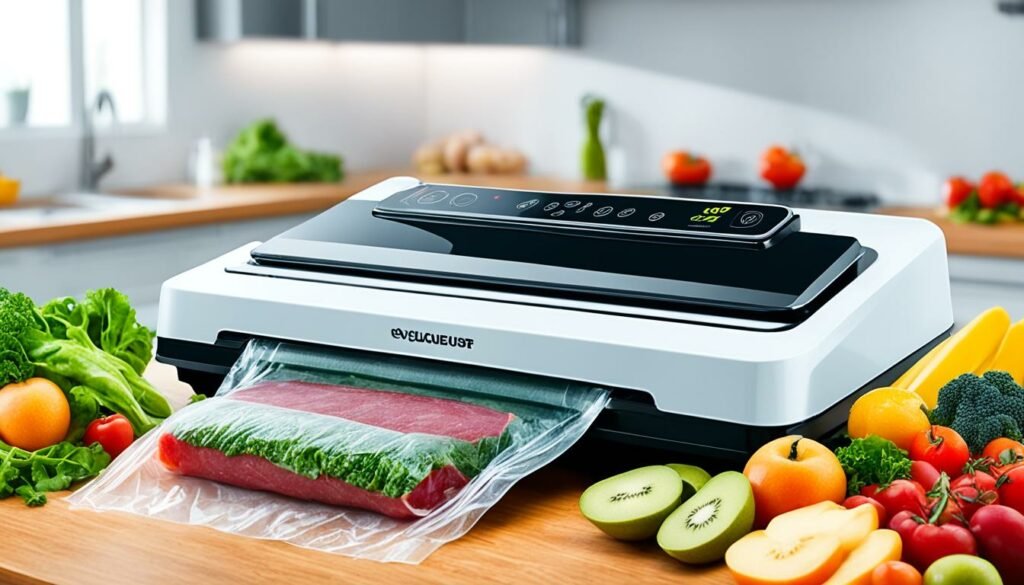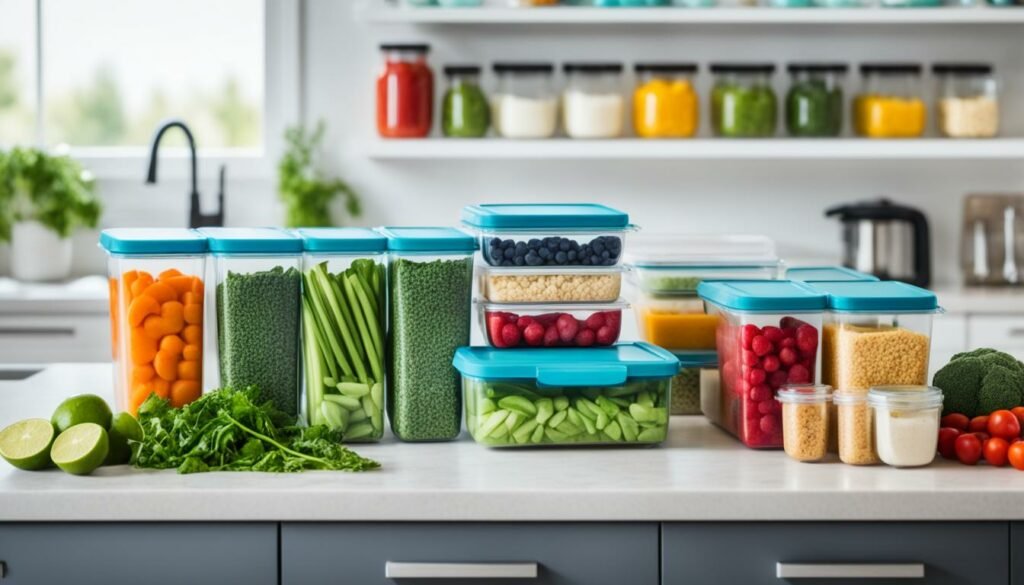Have you thought about cutting down food waste to save money? The savings might surprise you!
Americans throw away about 25% of the food they buy. This comes to over $1,500 each year. By using an energy-efficient vacuum sealer, you can change this. Products like the OutofAir seal in freshness, so you have to shop less. This means your food stays good for weeks or months. You avoid freezing snacks like chips and pastries.
Vacuum sealing is more than saving food. It’s part of living sustainably. This choice can save you a lot of money over time. It works well whether you’re just planning meals or watching your portions closely.

Wondering how to make your home more efficient and save money with vacuum sealing? Let’s find out!
Introduction to Energy-Efficient Vacuum Sealing
Vacuum sealing is changing the way we store food. It keeps food fresh longer and helps save energy. This method reduces food waste and helps people use less energy at home.
It means you shop less often and need less fridge space. This leads to a more efficient kitchen. By keeping food fresh and allowing bulk buys, sealing with energy-efficient appliances is great for those who care about the environment and saving money.
Reduce Food Waste and Save Money
Eating all the food you buy helps you save a lot of money every day. Using a vacuum sealer is a great way to keep food fresh longer. This lowers your grocery bill by making your food last longer.
Extending Shelf Life of Various Foods
When you vacuum seal food, you take out the air. This air causes food to spoil and change color. Vacuum sealing works well for many types of food. For instance:
- Meats don’t go bad quickly and won’t get ruined by the freezer.
- Bread and cakes stay soft and tasty.
- Beans and grains stay fresh for a long time.
Using these food saving methods helps you throw away less. This means you spend less money on groceries.
Preventing Spoilage
Vacuum sealing also stops food from spoiling. The OutofAir vacuum sealer is especially good at this. Putting seasoning on meats before sealing keeps them more delicious. It also protects them in the freezer.
Making and freezing meals early helps you plan better and use food well. This also cuts down on food waste.
Let’s look at how long different foods stay fresh when vacuum sealed:
| Food Type | Normal Shelf Life | Vacuum Sealed Shelf Life |
|---|---|---|
| Raw Meat | 6 months | 2-3 years |
| Bread | 1 week | 1-2 years |
| Beans | 1 year | 2-3 years |
| Dry Goods | 6-12 months | 2-4 years |
Bulk Buying and Long-Term Storage Benefits
Buying in bulk and storing for the long haul using vacuum sealing is a smart move. The cost of a vacuum sealer pays off by saving money over time. When you buy more, prices per item drop. The excellent sealing of a vacuum sealer keeps food fresh longer, cutting down on waste.
This also means you use up fewer resources, making it good for the planet.
Savings from Buying in Bulk
Buying food in bulk and vacuum sealing it keeps everything fresh longer. This not only saves money but also means fewer trips to the store. For example, vacuum-sealed meat stays good in the freezer for up to six months.
This beats the usual 6-12 months. It means you can enjoy bulk discounts longer without worrying about food going bad.
Optimal Storage Solutions
Vacuum sealing works great for both the fridge and freezer. It makes everything fit better and stay organized. Plus, it stops freezer burn and food spoilage.
This makes storing food a lot friendlier to the environment. With vacuum sealing, food lasts in the fridge for 1-2 weeks. Normally, it’s only good for 1-3 days.
Vacuum sealing really helps with saving money in the long run. It lets you keep bulk food fresh for ages, saving on grocery trips and waste.
Aid in Meal Preparation and Portion Control
Vacuum sealing is a big help in the kitchen. It makes making meals and controlling portions easier. You save time and money by not ordering pricey takeout or rushing to the store. By preparing your meals ahead of time, your week’s food is always ready.

Preparing Meals in Advance
With vacuum sealing, you can prepare meals efficiently. You cook and seal many meals at once, keeping them fresh. Having meals ready to go means less running to the store and less food waste.
Efficient Portion Control
Getting meal sizes right before sealing helps with healthy eating and stops overeating. It makes your food last longer, saving you money. Plus, meals stay tasty and fresh even after three months with vacuum sealing.
So, using vacuum sealing not only helps with cooking and eating better but with saving money. It’s great for families wanting to be smarter with their budget while keeping meal quality high.
How Energy-Efficient Vacuum Sealing Saves Money
Vacuum sealing saves cash by reducing food waste and how much energy you use. The average American family throws out a quarter of their food and drinks yearly, costing over $1,500. By sealing food, you make it last much longer, so you don’t go to the store as often. This means you spend less and save a lot of energy.
Buying food in bulk saves money right away. When you seal bulk items, they stay fresh for longer. This is great for things like cleaning supplies, dry goods, and beans. For example, sealing dry beans can make them last up to six months, a great tip for people who buy a lot and use them slowly.
Also, sealed bread, meats, and cheeses stay fresh longer. This means you can have cost-effective meals. Investing in a good vacuum sealer, like OutofAir, is smart. They come with a 360-day warranty, offering peace of mind and saving money in the long run.
Sealing food means you don’t need to keep replacing what goes bad. It saves space and keeps food fresh. Sealed meats also marinate much faster, making meals tastier and saving time.
| Item | Ordinary Shelf Life | Vacuum Sealed Shelf Life |
|---|---|---|
| Fruit & Vegetables | 1-6 days | 2 weeks – 2 years |
| Dairy Products | 1-2 weeks | 4-8 months |
| Dry Groceries | 6 months | Up to 2 years |
| Meat | 6-12 months | 2-3 years |
| Oils | 5-6 months | 12-18 months |
Sealing snacks like chips keeps them crunchy. This means you throw away less and enjoy every snack more.
Vacuum-sealed meal preps are fresh and convenient. They save time because you can reheat them quickly. Using a Cryovac machine can also save money. It makes your prepping more efficient and speeds up marinating. This way, you save big by wasting less and keeping your food better for longer.
Enhanced Food Quality and Safety
Vacuum sealing your food makes sure it stays fresh and safe to eat. This method takes the air out of the package. So, it keeps the food’s good taste and nutrients locked in.
Preventing Freezer Burn
Vacuum sealing also stops freezer burn. It stops ice crystals from forming on your food. This means your meats, fruits, and baked goods stay fresh and tasty. No more worrying about your food losing quality.
Maintaining Taste and Texture
Another great thing is how it keeps food tasting and feeling good. Vacuum sealing means food stays in a perfect, controlled space. So, it keeps all the flavors and juices right where they should be.
This way, your frozen vegetables stay crunchy. And your poultry stays moist. It’s a clear win for every kitchen.
Also, sealed food stays away from bad things in the air. A vacuum seal protects your food from dust, water, and bugs. This means your meals are always safe and of the best quality. Truly, vacuum sealing your food is a smart move for quality and safety.